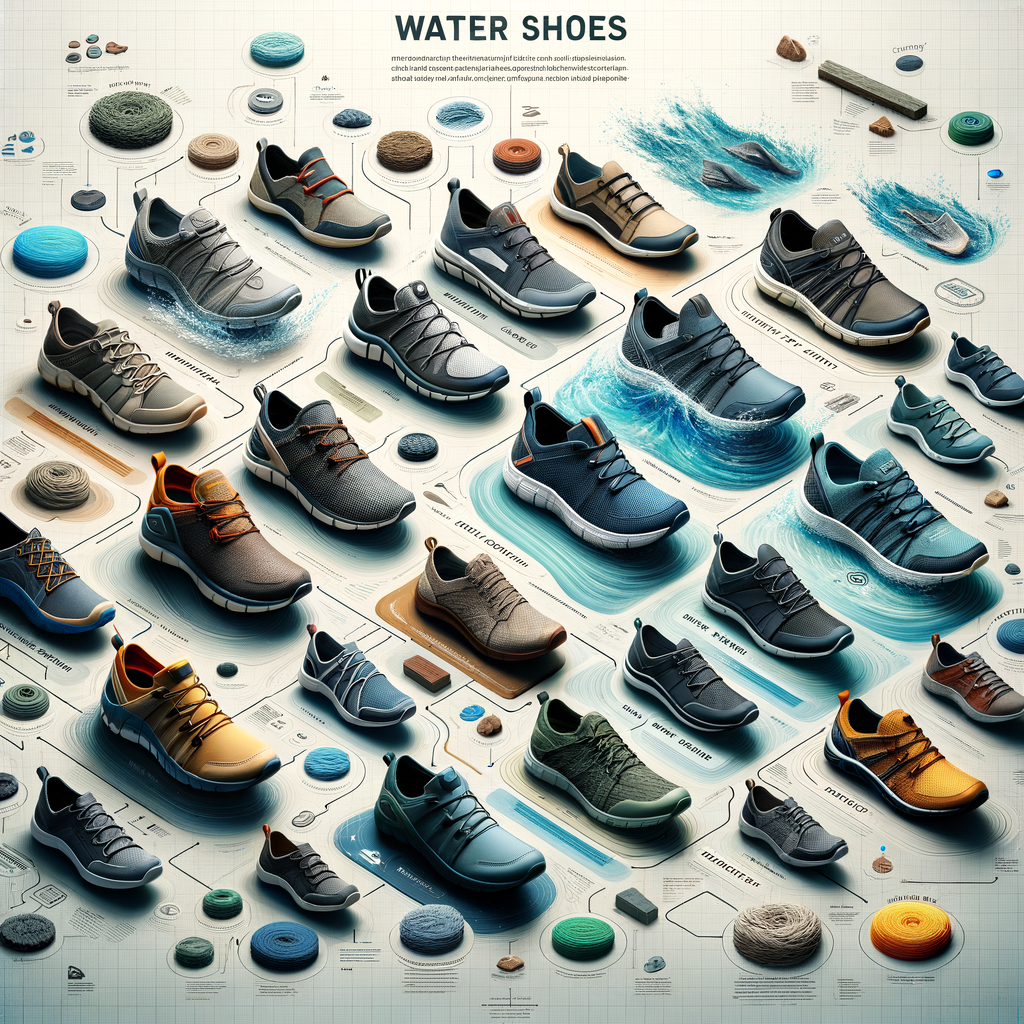
Introduction to Water Shoes
Water shoes, a type of footwear designed specifically for activities involving water, have become increasingly popular in recent years. But what exactly are water shoes, why are they important, and how have they evolved over time? In this section, we will explore these questions in detail.
- Understanding the concept of water shoes
- Importance of water shoes
- Evolution of water shoes designs
Water shoes are a unique type of footwear designed to protect your feet while engaging in water-based activities. Unlike regular shoes, they are made with quick-drying materials and have a hard sole to protect your feet from sharp objects. They are typically lightweight and offer a snug fit to ensure they stay on your feet, even in moving water.
Water shoes are essential for several reasons. Firstly, they provide protection. Whether you’re walking on a rocky beach or exploring a riverbed, water shoes safeguard your feet from sharp objects and rough surfaces. Secondly, they offer excellent traction, preventing slips and falls on wet surfaces. Lastly, they provide comfort. The quick-drying material prevents water logging, keeping your feet dry and comfortable.
Over the years, water shoes have evolved significantly. The earliest versions were simple rubber shoes, offering minimal protection and comfort. However, with advancements in technology and design, modern water shoes are far more sophisticated. They now come in various styles, from sandals and slip-ons to lace-ups, and are made with advanced materials for better comfort, protection, and durability. Some even feature removable insoles and drainage holes for faster drying.
In the following sections, we will delve deeper into the different types of water shoes, the materials used in their construction, and how to choose the right pair for your needs. So, whether you’re a seasoned water sports enthusiast or just planning your first beach vacation, stay tuned to learn more about this essential piece of footwear.
Exploring Different Types of Water Shoes
There are several types of water shoes available in the market, each designed to meet different needs and preferences. Let’s explore some of the most popular types:
- Water Sandals: Water sandals are an excellent choice for those who enjoy water activities such as kayaking or beachcombing. They have open designs that allow water to drain quickly, keeping your feet cool and comfortable. These shoes often have rugged soles for better grip on slippery surfaces.
- Aqua Socks: Also known as swim shoes, aqua socks are lightweight and fit snugly around your feet like a second skin. They are perfect for swimming, snorkeling, or any water sport that requires you to have a good feel of your foot movements. They protect your feet from sharp objects and hot surfaces while providing a barefoot-like experience.
- Water Sneakers: These are similar to regular sneakers but with features adapted for water use. Water sneakers have quick-drying materials and non-slip soles. They are ideal for water sports that require more foot protection, such as white-water rafting or paddleboarding.
- Boat Shoes: Boat shoes are designed specifically for boating activities. They have non-marking soles that provide excellent grip on wet boat decks. They are usually made of leather or canvas, offering a stylish look while keeping your feet dry and comfortable.
Remember, the best water shoe for you depends on your activity and personal preferences. Consider the type of water activity you’ll be doing, the conditions you’ll be facing, and the level of comfort and protection you need when choosing your pair.
Materials in Water Shoes
Water shoes are designed to protect your feet while providing comfort and traction in wet environments. The materials used in their construction play a significant role in their performance. Let’s explore the common materials used in water shoes.
Common Materials Used in Water Shoes
There are several materials commonly used in the manufacturing of water shoes. Each material has its unique properties that contribute to the overall functionality of the shoe. Here are the most common ones:
- Mesh: Mesh is a popular material used in water shoes due to its lightweight and breathable nature. It allows water to drain quickly, keeping your feet dry and comfortable. Mesh also dries quickly, reducing the chance of unpleasant odors.
- Neoprene: Neoprene is a type of synthetic rubber that is highly resistant to water and heat. It provides excellent insulation, keeping your feet warm in cold water. Neoprene is also flexible and durable, making it a great material for water shoes.
- Rubber: Rubber is another common material used in water shoes. It is known for its waterproof properties and high durability. Rubber soles provide excellent traction on wet surfaces, preventing slips and falls.
- Leather: While not as common, leather is sometimes used in water shoes for its durability and comfort. However, it is important to note that not all types of leather are suitable for water exposure, and special care must be taken to maintain leather water shoes.
Understanding the materials used in water shoes can help you make an informed decision when purchasing. Whether you prioritize breathability, insulation, durability, or comfort, there’s a water shoe material that fits your needs.
Understanding Water Footwear Materials
-
Benefits of Mesh Material
Mesh is a popular material for water shoes because it is lightweight and breathable. This means your feet can stay cool and dry, even when you’re in the water. Mesh also dries quickly, so you don’t have to worry about your shoes staying wet for long after you’ve left the water. Plus, it’s flexible, which makes for comfortable shoes that can easily adapt to your foot’s shape.
-
Advantages of Neoprene
Neoprene is another great material for water shoes. It’s a type of synthetic rubber that’s resistant to water, oil, and heat. This makes it perfect for water activities, as it can protect your feet from sharp objects and rough surfaces. Neoprene is also known for its insulation properties, which can keep your feet warm in cold water.
-
Why Rubber is a popular choice
Rubber is a classic choice for water shoes because it’s waterproof and durable. It’s also very grippy, which can prevent slips and falls on wet surfaces. Rubber shoes can last for years, even with regular use in water. They’re also easy to clean, which is a big plus after a day at the beach or a hike through a stream.
-
Leather in Water Shoes
Leather might not be the first material you think of for water shoes, but it has its advantages. It’s very durable and can provide good support for your feet. Some water shoes use a special type of treated leather that’s water-resistant. However, leather shoes usually take longer to dry than shoes made of mesh or neoprene.
| Material | Benefits |
|---|---|
| Mesh | Lightweight, breathable, quick-drying, flexible |
| Neoprene | Water-resistant, insulating, protective |
| Rubber | Waterproof, durable, grippy, easy to clean |
| Leather | Durable, supportive, can be water-resistant |
Different Designs of Water Shoes
Water shoes come in various designs, each tailored to meet specific needs and activities. The design features of these shoes are what set them apart and make them suitable for different water-related activities. Let’s explore some of these design features.
Design Features of Water Shoes
Water shoes are not just any regular shoes. They are specially designed with features that make them perfect for water use. Here are some of the key features:
- Drainage Holes: These are small holes in the soles of the shoes that allow water to drain out. This feature prevents water from pooling in your shoes, keeping your feet dry and comfortable. It also helps the shoes to dry quickly after use.
- Non-Slip Soles: Water shoes are designed with non-slip soles to provide grip on wet and slippery surfaces. This feature is crucial for safety, especially when walking on wet rocks or slippery boat decks.
- Quick-Drying Materials: Water shoes are made from materials that dry quickly. This is an important feature because it prevents the growth of bacteria and fungus, which can lead to foot infections. Quick-drying materials also make the shoes more comfortable to wear after they get wet.
- Comfortable Fit: Water shoes are designed to fit comfortably. They often have adjustable straps or elastic materials that ensure a snug fit. A comfortable fit is important because it prevents the shoes from slipping off your feet when you’re in the water.
These design features make water shoes versatile and suitable for a wide range of activities, from swimming and boating to hiking and casual wear. When choosing water shoes, consider these features and how they align with your needs and activities.
Water-Resistant Shoe Designs
Water-resistant shoes come in a variety of designs to suit different activities. Whether you’re hiking, swimming, boating, or simply looking for a casual pair, there’s a water shoe design for you. Let’s explore these designs in detail.
- Designs for Hiking
- Designs for Swimming
- Designs for Boating
- Designs for Casual Wear
Hiking water shoes are designed to provide excellent traction and support on wet and slippery surfaces. They usually feature thick, non-slip soles and quick-drying materials to keep your feet dry and comfortable. These shoes are also lightweight and breathable, making them perfect for long hikes.
Swimming water shoes are designed to protect your feet from sharp objects and hot surfaces while you’re in the water. They are typically made with mesh materials for quick drainage and drying. The soles are thin and flexible, allowing for easy movement in the water.
Boating water shoes are designed to provide excellent grip on wet boat decks. They usually have non-slip soles and are made with quick-drying materials. Some boating shoes also have a closed-toe design for extra protection.
Casual water shoes are designed for everyday wear. They are comfortable, stylish, and practical. These shoes typically have a slip-on design and are made with breathable, quick-drying materials. They are perfect for beach outings, pool parties, or just a casual walk in the park.
In conclusion, water-resistant shoes come in a variety of designs to suit different activities. Whether you’re hiking, swimming, boating, or just looking for a casual pair, there’s a water shoe design for you. So, choose the right design based on your needs and enjoy the comfort and protection of water-resistant shoes.
The Water Shoes Guide: Choosing the Right Pair
Choosing the right pair of water shoes can be a daunting task, especially with the wide variety of options available. However, by considering a few key factors, you can ensure you select the perfect pair for your needs. Here’s a simple guide to help you make the right choice.
- Considering the Activity
- Checking the Material
- Examining the Design
- Trying on for Comfort
The first step in choosing the right pair of water shoes is to consider the activity you will be using them for. For instance, if you plan on using them for swimming, a lightweight design would be ideal. However, if you’re going to use them for hiking or trekking, you’ll need a pair with sturdy soles and good traction. Remember, the right shoe can enhance your performance and comfort.
The material of the water shoes is another crucial factor to consider. Water shoes are typically made from quick-drying materials like mesh or neoprene. These materials not only dry quickly but also provide excellent breathability. However, if you need more durability, you might want to consider water shoes made from leather or synthetic materials. Always choose a material that suits your activity and comfort needs.
When it comes to design, water shoes come in various styles, from slip-ons to lace-ups. Some designs offer better support and protection, while others focus on ease of use and comfort. For example, a lace-up design might be ideal for activities that require a secure fit, while a slip-on might be more suitable for casual beach outings. Therefore, choose a design that best fits your activity and personal style.
Last but not least, always try on the water shoes for comfort. A good pair of water shoes should fit snugly but not too tightly. They should also provide good arch support and have a comfortable insole. Remember, comfort is key when it comes to any footwear, and water shoes are no exception. So, take your time and try on several pairs before making your final decision.
In conclusion, choosing the right pair of water shoes involves considering the activity, checking the material, examining the design, and trying them on for comfort. By keeping these factors in mind, you can ensure you select the perfect pair that meets your needs and enhances your water activities.
Case Studies: Success Stories with Water Shoes
Let’s dive into some real-life examples of how water shoes have made a significant difference in the lives of outdoor enthusiasts. These case studies highlight the practicality and benefits of water shoes in various water-related activities.
-
Case Study 1: The Hiker’s Companion
John, an avid hiker, used to struggle with crossing streams and wet trails during his hikes. He often slipped and had to deal with soggy shoes for the rest of his journey. Everything changed when he discovered water shoes. These shoes provided him with the necessary grip and quick-drying feature, making his hiking experience much more enjoyable and safe. John now recommends water shoes to all his hiking buddies.
-
Case Study 2: The Swimmer’s Best Friend
Sarah, a professional swimmer, was always concerned about the slippery pool sides and the risk of foot infections. When she started using water shoes, she found them to be a game-changer. The shoes offered her excellent traction, reducing the risk of slips and falls. Moreover, the water shoes acted as a barrier against any potential fungal infections. Sarah now considers her water shoes as an essential part of her swimming gear.
-
Case Study 3: The Boater’s Safety Net
Mike, a boating enthusiast, used to find it challenging to maintain his footing on the wet boat deck. After a close friend recommended water shoes, Mike decided to give them a try. The water shoes provided him with the stability he needed on the slippery deck. They also dried quickly, ensuring his comfort throughout his boating trips. Mike now feels more confident and safe during his boating adventures, thanks to his water shoes.
These case studies clearly demonstrate the practicality and benefits of water shoes in different scenarios. Whether you are a hiker, a swimmer, or a boater, water shoes can significantly enhance your safety and comfort during your water-related activities.
Conclusion: The Future of Water Shoes
As we look ahead, the future of water shoes is bright and promising. The industry is poised for significant growth, driven by advancements in materials, innovations in design, and increasing popularity and demand. Let’s delve into these aspects further.
- Advancements in Materials
- Innovations in Design
- Increasing Popularity and Demand
Material technology is evolving at a rapid pace. In the future, we can expect to see water shoes made from more durable, lightweight, and eco-friendly materials. For instance, the use of recycled plastics in shoe production is already gaining traction. This not only reduces environmental impact but also enhances the longevity and comfort of the shoes. Moreover, advancements in waterproofing technologies will make water shoes even more effective at keeping feet dry and comfortable.
Design innovation is another area where we can anticipate significant progress. With the integration of advanced computer modeling and 3D printing, the design possibilities for water shoes are virtually limitless. These technologies will allow for more precise fitting, improved ergonomics, and even the possibility of custom-designed water shoes tailored to an individual’s specific needs and preferences.
The demand for water shoes is on the rise, and this trend is expected to continue. As more people engage in water-based activities like kayaking, paddleboarding, and beachcombing, the need for high-quality water shoes will increase. Furthermore, as consumers become more aware of the benefits of water shoes – such as improved grip, foot protection, and comfort – their popularity is likely to soar.
In conclusion, the future of water shoes is exciting. With advancements in materials, design innovations, and increasing demand, we can expect to see a new generation of water shoes that are more comfortable, durable, and eco-friendly than ever before. The journey of water shoes from a niche product to a mainstream footwear choice is just beginning, and we can’t wait to see where it leads.











